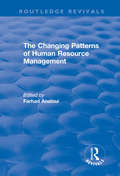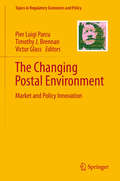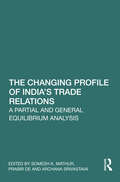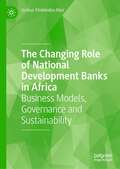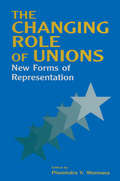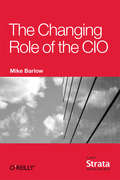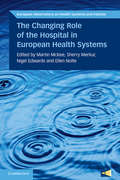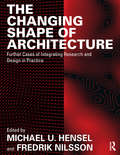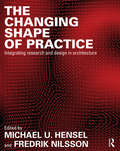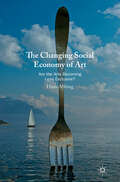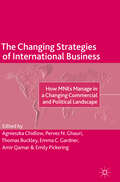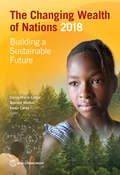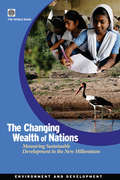- Table View
- List View
The Changing Patterns of Human Resource Management
by Farhad AnalouiThis title was first published in 2002: Human Resource Development (HRD) arguably constitutes the most important aspect of managing resources at work. In this context, HRD has for some time played a significant role in Western business management. This volume focuses on the changing role of human resource management (HRM) on an international spectrum, and its implication for the role that HRM plays within organizations in developed and developing economies. Critically assessing HRM in the context of public and private organizations and NGOs based in South East Asia, Africa, the Middle East and Eastern Europe, the volume focuses on the role of managers as both influenced and influencing change agents who determine the future of HRM. It examines changing patterns of HRM in terms of orientation, initiatives, policies and practices, and explores the possibility of a more flexible and constructive approach to ’gender’ as women increasingly occupy more managerial and executive positions.
The Changing Politics of Finance in Korea and Thailand: From Deregulation to Debacle (RIPE Series in Global Political Economy #No.8)
by Xiaoke ZhangThis is the first systematic attempt to explore the causal relationship between financial market reform and financial crisis in an interdisciplinary and comparative perspective. It examines the political underpinnings of financial policy-change and provides an in-depth analysis of market liberalisation processes and their impact on the economic turmoil of 1997-98 in Korea and Thailand. The common crisis stemmed from divergent reform patterns and originated from dissimilar institutional deficiencies and political constraints.The book will be essential reading for both policy-makers and academics concerned with national governance in an era of globalisation.
The Changing Postal Environment: Market and Policy Innovation (Topics in Regulatory Economics and Policy)
by Timothy J. Brennan Pier Luigi Parcu Victor GlassThis book addresses major issues facing postal and delivery services throughout the world. Worldwide, there is currently a considerable amount of interest in postal and delivery economics. The industry is reacting to a state of near crisis and is implementing different drastic changes. The European Commission and member States are still wrestling with the problem of how to implement entry liberalization into postal markets, how to address digital competition, and how to maintain the Universal Service Obligation (USO).Digitalization, technological development and online platforms are strongly affecting both the way postal and delivery operators are managing their services, as well as their role on the market. Strong emphasis was attributed to the assets of Postal Operators (POs) and their added value in the digital age, as well as on new business strategies. This volume presents original essays by prominent researchers in the field, selected and edited from papers presented at the 27th Conference on Postal and Delivery Economics held in Dublin, Ireland, 22-25 May, 2019. Topics addressed by this volume include the fragmentation of the postal supply chain, blockchain and digital postal services, and the fading of traditional postal market boundaries. This book will be a useful tool not only for graduate students and professors, but also for postal administrations, consulting firms, and federal government departments.
The Changing Profile of Corporate Climate Change Risk (Doshorts Ser.)
by Mark Trexler Laura KosloffThis book will help business executives to (1) rethink their perceptions of climate risk (2) evaluate whether their company is effectively positioned, and (3) make informed and prudent business decisions about climate change risk in an environment rife with policy uncertainty.Business risk associated with climate change is commonly assumed to be primarily policy driven. Many companies internalize the current stalemate over global climate policy into a perception that climate risk is no longer a critical issue. Business climate risks, however, include: Operational and Supply Chain (Physical) Risk, Brand Risk, Market-driven Structural Risk, Liability Risk.As national and global policy to materially reduce climate change is delayed, it is business-prudent to assume that the level of climate risk is increasing. Even if policy risk might seem lower today than a few years ago, political will can change quickly. Should physical impacts of climate change manifest in dramatic ways, for example, draconian climate policy is likely to follow quickly. These conditions create a complex and shifting business risk environment, and most companies either overlook or substantially underestimate key climate risks. How many companies, for example, are positioned for material climate change outcomes, whether physical or regulatory? Companies with little climate change exposure may not face much downside risk from taking a wait-and-see approach. For those with greater exposure, being "too late" to respond will mean costs and competitive impacts that could have been avoided. Being "too early," however, can mean being penalized later for actions that reduce a company’s emissions today, or competitive disadvantage from getting too far out in front of competitors.
The Changing Profile of India’s Trade Relations: A Partial and General Equilibrium Analysis
by Somesh K. Mathur, Prabir De and Archana SrivastavaThis book unravels the complex spectrum of trade policy in India with the help of partial and general equilibrium models. It evaluates India’s recent trade deals with the UAE, Australia, European Free Trade Area (EFTA), and Mauritius, among others.Using applied general equilibrium methods to analyse recent debates about the conduct of India’s trade policy, this book aims to present how the barriers to trade have been affecting trade flows. It further presents a set of large-scale computable general equilibrium simulations of the effects of changes in trade barriers. It also explores India's need to deal strategically with China and provide different economic solutions, despite the conflicts along their international borders. Moreover, it focuses on how India, through its trade orientation, needs to manage its natural resources and deal with land scarcity.The volume will be of interest to scholars and researchers of international trade and finance, business economics, and econometrics. It will also be of interest to foreign trade experts, researchers, policy makers and government officials, among others.
The Changing Public Sector: A Practical Management Guide
by Malcolm ProwleThe public sector in the UK has undergone radical change over the last two decades. Consequently, managers and service professionals have had to adopt new ways of working and acquire a wide range of new managerial skills to deal with the changes that have taken place. The continuing process of change in the public sector also means that these managerial skills need to be continually maintained and developed. This book provides comprehensive coverage of public sector management approaches covering: ¢ Strategy ¢ Finance ¢ Human resources ¢ Marketing ¢ Quality ¢ Information systems. Thus it provides managers, professionals and students with a clear understanding of the main elements of each aspect of management as applied in public sector organizations. The book also outlines the ongoing changes which will impact on public sector organizations in the future and discusses the implications of these changes for public sector management methods.
The Changing Role Of Central Banks
by Dimitris N. ChorafasThe Changing Role of Central Banks derives lessons from current economic and financial challenges as well as failures in confronting them. Through this approach, it brings under perspective political and social reactions to major economic problems of the last ten years, particularly those pertaining to money and initiatives taken by central banks.
The Changing Role of Criminal Law in Controlling Corporate Behavior
by James M. Anderson Ivan WaggonerThis report addresses the use of criminal sanctions to control corporate behavior prosecutions both of corporations and of employees for actions taken on corporations behalf. The authors describe the current state of the use of criminal sanctions in controlling corporate behavior, describe how the current regime developed, and offer suggestions about how the use of criminal sanctions to control corporate behavior might be improved. "
The Changing Role of Export Credit Agencies
by Malcolm StephensA report from the International Monetary Fund.
The Changing Role of National Development Banks in Africa: Business Models, Governance and Sustainability
by Joshua Yindenaba AborThis book examines the changing role of national development banks (NDBs) in Africa. It presents a comprehensive overview of NDBs in Africa, examining their key characteristics, theoretical underpinnings, and growing importance to African economies.The book fully examines the role of NDBs and their potential to support development goals, address gaps in finance left by underdeveloped capital markets, and mobilize resources from the public and private sectors to encourage new long-term investments. Chapters cover the historical background and theoretical rationale for NDBs; the contemporary role of NDBs including their role in sustainable development, climate finance initiatives, and infrastructure development; funding sources, business models, monitoring and impact evaluation; and corporate governance, risk management and regulation. Case studies are also included to demonstrate the individual contributions of NDBs to several national economies.The book contributes to the limited literature in this area by providing a detailed resource on NDBs for scholars, students, policymakers and regulators working in the areas of development finance and banking.
The Changing Role of SMEs in Global Business: Volume I: Paradigms of Opportunities and Challenges (Palgrave Studies in Cross-disciplinary Business Research, In Association with EuroMed Academy of Business)
by Demetris Vrontis Yaakov Weber Alkis Thrassou Evangelos Tsoukatos S. M. Riad ShamsSMEs are significant job creators and drivers of innovation and competition in most economic sectors. Furthermore, the traditional constraints of small and medium enterprises, such as geographic operations, are now being dissolved by technological developments. This means that there are new opportunities for SMEs, and their fundamental principles are being redefined: the aims, competencies, strategy, management, practice, and scope of these businesses are changing, with wide-ranging implications. This is the first part of a two volume work that incorporates scientific chapters on SME business theory and practice. Authors provide a balanced perspective of the present and future of SMEs across all business disciplines, including management, strategy, marketing, economics, and finance. While Volume II explores external issues such as contextual forces, the effects of the financial crisis, and macro-economic effects, this first volume focuses on the individual SME and internal issues such as innovation, quality, and digitization.
The Changing Role of SMEs in Global Business: Volume II: Contextual Evolution Across Markets, Disciplines and Sectors (Palgrave Studies in Cross-disciplinary Business Research, In Association with EuroMed Academy of Business)
by Demetris Vrontis Yaakov Weber Alkis Thrassou Evangelos Tsoukatos S. M. Riad ShamsSMEs are significant job creators and drivers of innovation and competition in most economic sectors. Furthermore, the traditional constraints of small and medium enterprises, such as geographic operations, are now being dissolved by technological developments. This means that there are new opportunities for SMEs, and their fundamental principles are being redefined: the aims, competencies, strategy, management, practice, and scope of these businesses are changing, with wide-ranging implications.This is the second part of a two volume work that incorporates scientific chapters on SME business theory and practice. Authors provide a balanced perspective of the present and future of SMEs across all business disciplines, for example management, strategy, marketing, economics and finance. While Volume I focuses on the individual SME and internal issues such as innovation, quality, and digitization, this second volume explores external issues such as contextual forces, the effects of the financial crisis, and macro-economic effects.
The Changing Role of Unions: New Forms of Representation
by Phanindra V. WunnavaWith the trend toward multinational corporations, free trade pacts and dismantling import barriers, organized labour has been steadily losing ground in the United States. To reverse this trend, this book argues that US unions must create ties with unions in other countries.
The Changing Role of the CIO
by Mike BarlowDoes Big Data represent an existential threat to CIOs? Yes, quite possibly. For the past three decades, corporate CIOs have served primarily as stewards and guardians of IT infrastructure. Big Data -- together with cloud, social and mobile computing -- throws the value of legacy IT infrastructure into question and undermines the traditional authority of CIOs over the systems they have championed. For corporate CIOs, getting comfortable with Big Data will require reaching beyond the traditional comfort zone of IT and learning a new language that combines business, math and behavioral science, with signficantly less emphasis on traditional infrastructure technology than in the past. Will CIOs be ready and willing to make the leap?
The Changing Role of the Hospital in European Health Systems (European Observatory on Health Systems and Policies)
by Ellen Nolte Sherry Merkur Martin McKee Nigel EdwardsHospitals today face a huge number of challenges, including new patterns of disease, rapidly evolving medical technologies, ageing populations and continuing budget constraints. This book is written by clinicians for clinicians and hospital managers, and those who design and operate hospitals. It sets out why hospitals need to change as the patients they treat and the technology to treat them changes. In a series of chapters by leading authorities in their field, it challenges existing models, reviews best practice from many countries and presents clear policy recommendations for policymakers and hospital administrators. It covers the main patient groups and conditions as well as those departments that make modern effective care possible, in imaging and laboratory medicine. Each chapter looks at patient pathways, aspects of workforce, required levels of specialisation and technology, and the opportunities and challenges for optimising the delivery of services in the hospital of the future. This title is also available as Open Access on Cambridge Core.
The Changing Role of the Management Accountants: Becoming A Business Partner
by Vassili Joannidès de Lautour Panida ChotiyanonThis book presents a comprehensive and holistic study on being a financial practitioner today. Using a practice theory approach, the book analyzes the work life stories of four financial practitioners who have been working between 13 and 25 years during the period of 1973 to 2015 and explains how their work identities are constituted in the practices throughout the years. It clarifies the public image of the management accountants and provides a better understanding of today’s management accountants—who they are and how they are formed—while theorizing on how to develop the next generation.
The Changing Shape of Architecture: Further Cases of Integrating Research and Design in Practice
by Fredrik Nilsson Michael U. HenselThe discipline of architecture is currently undergoing a significant change as professional practice and academia seem to be transforming one another specifically through succinct research undertakings. This book continues the discussion started in The Changing Shape of Practice – Integrating Research and Design in Architecture on architectural offices’ modes of research and lines of inquiry in architecture and how it reshapes practice. The book aims to contribute to the mapping and discussion on research in architectural practice and its transformational impact and gives input to the discussions on where the architectural profession is heading. In this second volume, various research initiatives and modes in architectural practices are portrayed. The book also includes contributions that broaden the scope and put the developments into larger contexts, and present an overview of developments from different regional perspectives and of various social aspects of architecture. It also relates the developments in practice to educational efforts and to initiatives where the more traditional role of architects is challenged. The contributions include chapters by Walter Unterrainer, Anthony Burke, Renée Cheng and Andrea J. Johnson, and Michael U. Hensel, and on the practices atelier d’architecture autogérée, Helen & Hard, MVRDV and The Why Factory, NADAAA & Nader Tehrani, Nordic – Office of Architecture, Schmidt Hammer Lassen, Skidmore, Owings & Merrill, Void, Sarah Wigglesworth Architects, and Älvstranden Utveckling.
The Changing Shape of Practice: Integrating Research and Design in Architecture
by Fredrik Nilsson Michael U. HenselArchitectural practices worldwide have to deal with increasingly complex design requirements. How do practices acquire the ability to do so? The Changing Shape of Practice provides a handbook of examples for practices that wish to integrate more research into their work and a reference book for students that seek to prepare themselves for the changing shape of practice in architecture. It addresses the increasing integration of research undertaken in architectural practices of different sizes ranging from small to very large practices from the UK, USA, Europe and Asia. The book is organized according to the size of the practices which is significant in that it addresses the different structures and resourcing requirements that are enabled by specific practice sizes, as this determines and constrains the type, scope and modes of research available to a given practice. The practices covered include: Woods BagotPerkins + WillWhiteAECOMUN StudioShop ArchitectsPLP ArchitectureKieran Timberlake3XNONLAZPMLThomas Herzog + PartnersHerreros ArquitectosSpacescapeOCEAN Design Research Association By taking stock of the current shape of practice, the book provides essential information for professional architects who are integrating research into their practice.
The Changing Social Economy of Art: Are the Arts Becoming Less Exclusive?
by Hans AbbingIs art for everybody? Why do art lovers attach so much value to authenticity, autonomy and authorship? Why did the arts become so serious in the first place? Why do many artists reject commerce and cultural entrepreneurship? Crucially, are any of the answers to these questions currently changing? Hans Abbing is uniquely placed to answer such questions, and, drawing on his experiences as an economist and sociologist as well as a professional artist, in this volume he addresses them head on. In order to investigate changes in the social economy of the arts, Abbing compares developments in the established arts with those in the popular arts and proceeds to outline key ways that the former can learn from the latter; by lowering the cost of production, fostering innovation, and becoming less exclusive. These assertions are contextualized with analysis of the separation between serious art and entertainment in the nineteenth century, lending credence to the idea that government-supported art worlds have promoted the exclusion of various social groups. Abbing outlines how this is presently changing and why, while the established arts have become less exclusive, they are not yet for everybody.
The Changing Strategies of International Business: How MNEs Manage in a Changing Commercial and Political Landscape (The Academy of International Business)
by Pervez N. Ghauri Agnieszka Chidlow Thomas Buckley Emma C. Gardner Amir Qamar Emily PickeringThe ACADEMY OF INTERNATIONAL BUSINESS (UK and Ireland Chapter) Published in association with the UK and Ireland Chapter of the Academy of International Business.In line with the 45th AIB-UKI conference, this edited collection brings together fresh perspectives on international business strategy, with a focus on the challenges faced by multinational enterprises (MNEs) in today’s changing commercial and political landscape. With a diverse range of contributors from varying international backgrounds, this book discusses the different strategies employed by MNEs, and analyses how they cope with the current global business environment. An extremely useful read for those studying globalisation and MNEs, this book provides an interdisciplinary and timely approach to international business strategy.
The Changing Structure of the World Oil Industry (Routledge Library Editions: Energy Economics)
by David HawdonOriginally published in 1985 by a group of international experts and oil industry officials, this book surveys the dramatic changes which took place in the oil industry in the second half of the twentieth century. It discusses the role of OPEC and the long term impact its decisions had for both producers and oil consumers and examines possible future trends in the oil industry structure and stability, together with the possible consequences for North Sea oil and gas development.
The Changing Wealth of Nations 2018: Building a Sustainable Future
by Quentin Wodon Kevin Carey Glenn-Marie LangeCountries regularly track gross domestic product (GDP) as an indicator of their economic progress, but not wealth—the assets such as infrastructure, forests, minerals, and human capital that produce GDP. In contrast, corporations routinely report on both their income and assets to assess their economic health and prospects for the future. Wealth accounts allow countries to take stock of their assets to monitor the sustainability of development, an urgent concern today for all countries. The Changing Wealth of Nations 2018: Building a Sustainable Future covers national wealth for 141 countries over 20 years (1995†“2014) as the sum of produced capital, 19 types of natural capital, net foreign assets, and human capital overall as well as by gender and type of employment. Great progress has been made in estimating wealth since the fi rst volume, Where Is the Wealth of Nations? Measuring Capital for the 21st Century, was published in 2006. New data substantially improve estimates of natural capital, and, for the fi rst time, human capital is measured by using household surveys to estimate lifetime earnings. The Changing Wealth of Nations 2018 begins with a review of global and regional trends in wealth over the past two decades and provides examples of how wealth accounts can be used for the analysis of development patterns. Several chapters discuss the new work on human capital and its application in development policy. The book then tackles elements of natural capital that are not yet fully incorporated in the wealth accounts: air pollution, marine fi sheries, and ecosystems. This book targets policy makers but will engage anyone committed to building a sustainable future for the planet.
The Changing Wealth of Nations: Measuring Sustainable Development in the New Millennium
by World BankThis book is the latest report by the World Bank to estimate comprehensive wealth -- including produced, natural and human / institutional assets -- for over 100 countries. This ground-breaking report presents wealth accounts for 1995, 2000, and 2005, permitting the first longer-term assessment of global, regional, and country performance in building wealth. This overall assessment is complemented by chapters detailing individual components of wealth, as well as how countries and the World Bank are using comprehensive measures of wealth for policy analysis.
The Changing World and Africa
by Xinfeng Li Chunying AnThis book brings contemporary Chinese scholarship into Africa, the relations between African states, and the relations between China and Africa into focus. As China becomes the biggest partner for many African states, constructing infrastructure across the continent, Western scrutiny has increased. This book offers a comprehensive look at what Chinese scholars have encountered on the ground, as well as comparative studies of how different nations have engaged with Africa.
The Changing World of Mobile Communications: 5G, 6G and the Future of Digital Services
by Annabeth Aagaard Petri AhokangasThis open access book from the world’s first 6G Flagship research program at the University of Oulu, Finland, provides a multi-disciplinary and insightful overview of the subject, with contributions from experts in the field. Today’s fourth generation of mobile connectivity services (4G) are available everywhere, and adoption of fifth generation (5G) networks is well underway. Compared to 4G, 5G has already brought about new business opportunities and enabled seamless virtual and augmented reality services, but also raised serious concerns on data privacy and security and the use of artificial intelligence. The sixth generation (6G) networks are already in R&D phase aiming at deployment in 2030. We need to understand today what 5G evolution and 6G may bring for the future of service delivery and how they will influence us. The contributions answer what 5G, its evolution, and 6G will be about; what kind of impacts 5G and 6G will have on future digital services, businesses, and society; how we could benefit from 5G and 6G innovations; and how 5G and 6G should be regulated in the future. Future 5G evolution and 6G are not only about moving toward faster, better, and more secure networks providing the basis for innovative digital services, they are also going to bring about a huge digital disruption that will affect all levels of society. This book will be of great interest to academics and students of management, telecommunications and digital innovation, as well practitioners and policymakers looking to the future of business.
